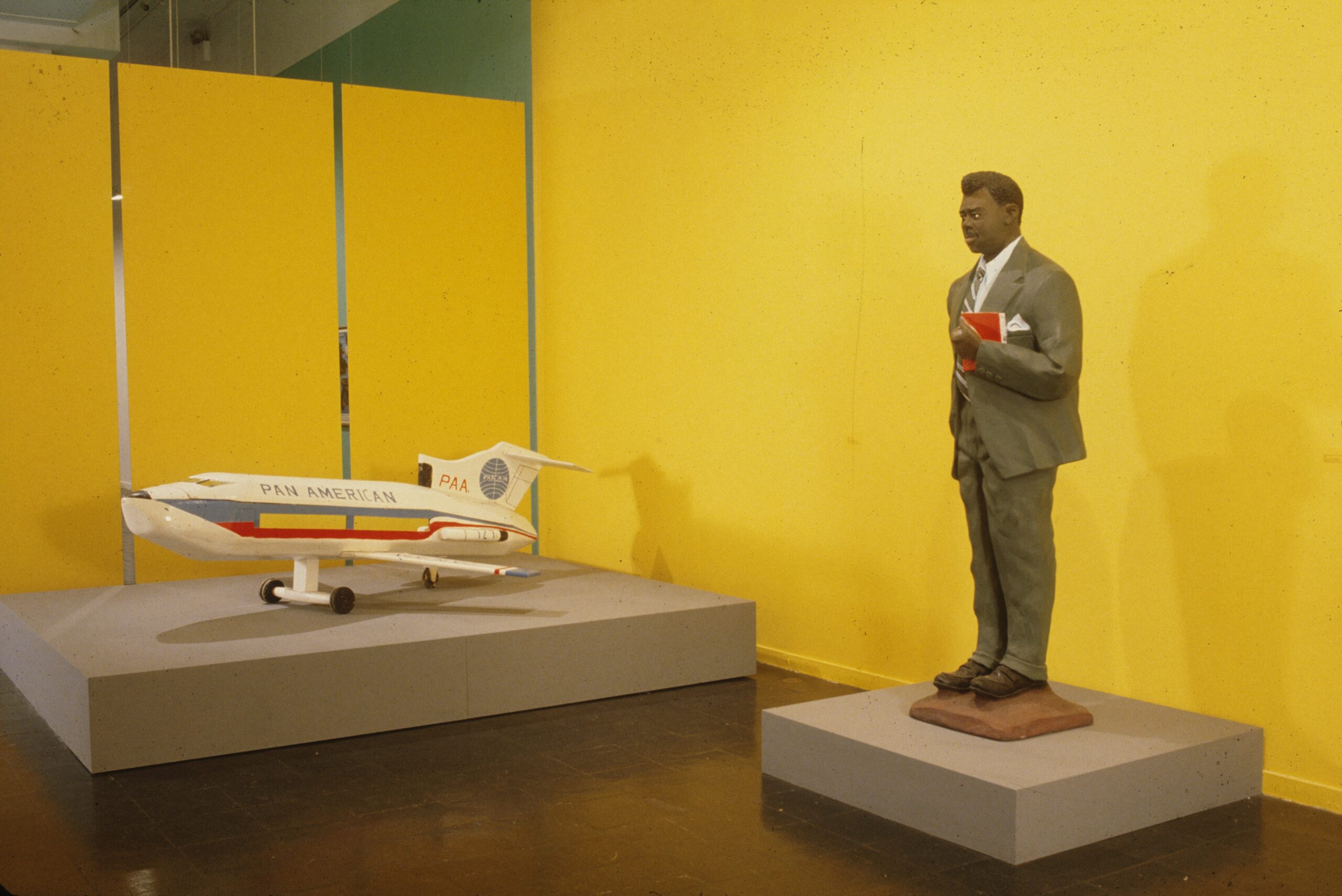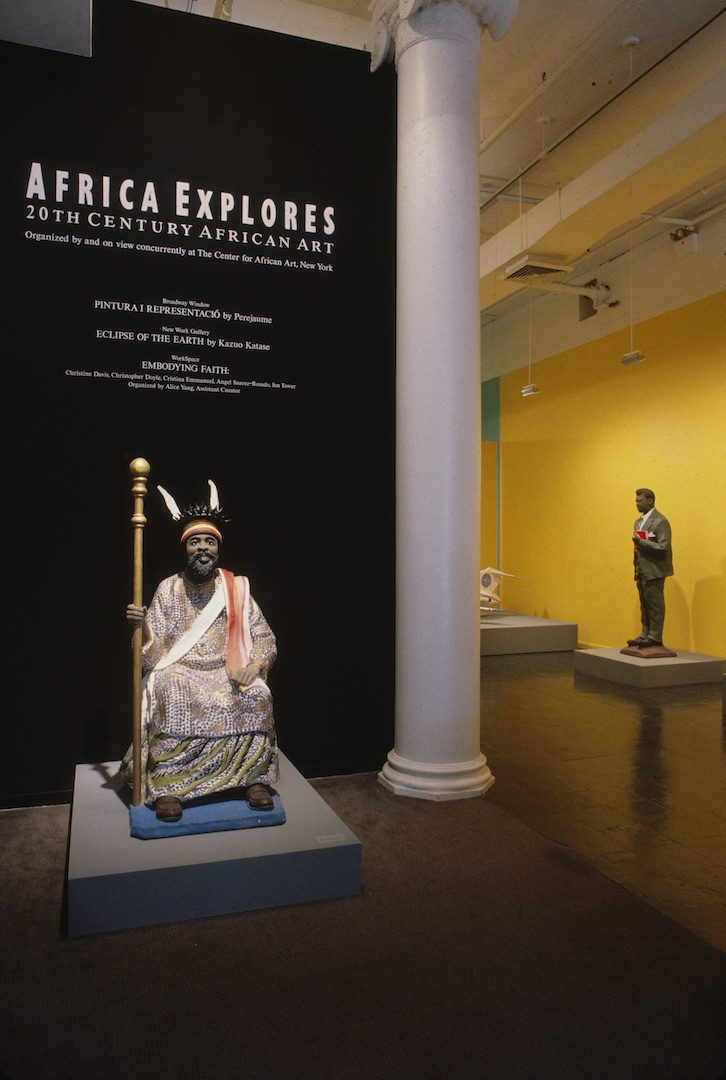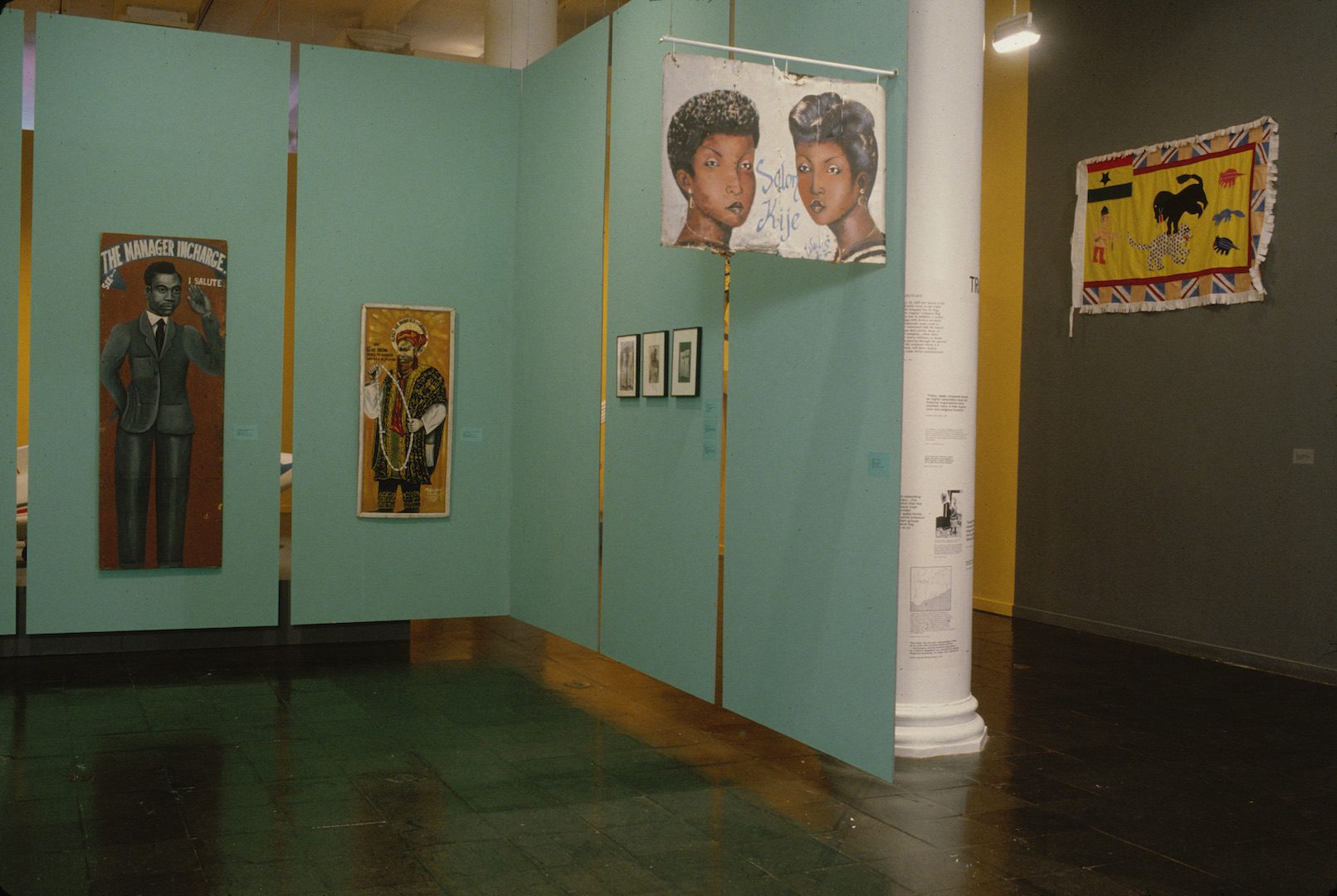Dans cette série, C& revisite les expositions les plus discutées, les plus appréciées, les plus détestées des dernières décennies, celles qui ont suscité la réflexion et qui ont changé la donne en matière d'art contemporain de perspective africaine. Nous nous penchons de plus près sur l'exposition Africa Explores.

Installation view of Sunday Jack Akpan and Kane Kwei Carpentry Workshop in Africa Explores: 20th Century African Art, New York 1991. Courtesy of New Museum, New York. Photo: Fred Scruton
En mai 1991 l‘exposition « Africa Explores » a été inaugurée à New York. Dans les espaces du Museum for African Art et du New Museum of Contemporary Art, la commissaire Susan Vogel a présenté plus de centre trente œuvres très hétéroclites provenant de quinze pays africains. Mélangeant différents médias et styles, « Africa Explores » souhaitait apporter un nouveau témoignage de la réalisation artistique dans l’Afrique du XXe siècle de sa propre perspective.
.
Concept et critique
Dans les deux musées, les visiteurs étaient accueillis dès l’entrée de l’exposition par des objets grandeur nature : un chef assis en ciment peint du peintre nigérian Sunday Jack Akpan inaugurait l’exposition. À côté étaient présentés des cercueils en forme de voitures, de légumes ou d’avions commercialisés depuis les années 1950 par Kane Kwei Carpentry Workshop au Ghana. La sélection de ces œuvres montrait dès le départ que Susan Vogel, directrice du Museum for African Art de l’époque, ne souhaitait pas se limiter à une seule forme de création artistique. Au contraire, « Africa Explores » s’attachait à présenter différents styles artistiques qui, selon elle, constituaient à part égale la pratique artistique du XXe siècle. Dans le catalogue de l’exposition, la commissaire décrit cinq types d’art qui se sont dégagés selon elle au cours de ses recherches. En premier lieu, le Traditional art (art traditionnel), qui serait avant tout pratiqué au sein de groupes ethniques et correspondrait à une utilité précise – comme les masques utilisés lors de rituels. Le New Functional art (nouvel art fonctionnel) est décrit par Vogel comme une forme nouvelle et éclectique de cet art traditionnel qui a recours à des matériaux et des motifs divers.
L’art populaire ou Urban art représentait le travail artisanal et commercial de peintres de panneaux et de graphistes autodidactes, tandis que l’International art (art international), les œuvres d’artistes urbains académiques. En dernier lieu, l’Extinct’ art (art disparu) est défini par la commissaire comme un art traditionnel du passé qui se trouve autant dans la mémoire collective que dans les collections des musées [1].
.

Entrance to the exhibition Africa Explores: 20th Century African Art, New York 1991. Courtesy New Museum, New York. Photo: Fred Scruton
.
Même si la sélection des œuvres était très hétérogène, Susan Vogel aspirait à une perspective très précise avec son exposition : « “Africa Explores” cherche à se concentrer sur l’Afrique, ses préoccupations, son art et ses artistes dans leurs propres contextes et avec leurs propres voix [2]. » Au lieu d’argumenter à partir d’une perspective « occidentale » comme dans l’exposition précédente « Magiciens de la Terre », l’objectif de Susan Vogel était de donner à voir les œuvres d’art au moyen de l’expérience et de la perspective de créateurs africains [3]. Cette intention ne fut toutefois pas clairement reflétée dans l’exposition.
Les catégories que Vogel avait établies dans son exposition lui valurent quelques critiques. La tentative de les camoufler sous des termes apparemment pertinents n’a pu masquer à quel point ses définitions étaient en réalité quelconques, dépassées et limitées. Tant Olu Oguibe qu’Okwui Enwezor y virent des instruments d’une classification anthropologique n’ayant que peu de choses à voir avec l’histoire de l’art [4]. Les nombreux travaux autodidactes et l’absence d’artistes nord-africains dans l’exposition penchent en faveur d’un intérêt ethnologique manquant de réflexion, étayé par la conception stéréotypée d’un « art africain authentique [5] ».
.

Installation view of Africa Explores: 20th Century African Art, New York 1991. Courtesy New Museum, New York. Photo: Fred Scruton
.
Ces catégories montraient aussi la légèreté avec laquelle Susan Vogel faisait de la publicité pour cette exposition à arguant des soi-disant « perspectives africaines ». Comme John Picton le souligna, ces termes n’étaient que des outils nécessaires à la mise en œuvre de l’exposition grâce auxquels présenter les œuvres au public sous forme d’amuse-gueules digestes [6]. Ils avaient été développés dans et par des institutions occidentales et n’avaient par conséquent rien à voir avec la perspective des artistes africains – l’annonce faite par Vogel qu’« Africa Explores », comme le titre le suggérait aussi, adopterait une autre perspective que la sienne resta une intolérable phrase toute faite. Même les deux contributions de V. Y. Mudimbe et Ima Ebong placées en prévention dans le catalogue d’exposition ne purent plus enrayer ce phénomène.
Susan Vogel concéda même dans la publication que – en raison de la situation – des auteurs américains avaient en majorité pris la parole, et les avait qualifiés, ainsi qu’elle-même, de « personnes extérieures de confiance ». Au vu du concept de l’exposition d’« Africa Explores », ce terme apparaît très ironique. Car ce n’est pas au commissaire ni à ses collègues que le rôle de personnes extérieures avait été attribué, mais bien aux artistes d’Afrique. Même Oguibe s’est exprimé à ce sujet : « The invited insider is only a stranger in his own discourse, swamped and drowned out. It is the ‘intimate outsider’ who truly is in charge [7] » (L’insider invité n’est qu’un étranger à son propre discours, submergé et noyé. C’est l’« outsider intime » qui est véritablement responsable.) Et celui-ci a livré dans « Africa Explores » uniquement une vision du monde digeste, transformée en catégories, dans lesquelles les véritables protagonistes n’étaient que les figurants.
.

Installation view of Africa Explores: 20th Century African Art, New York 1991. Courtesy New Museum, New York. Photo: Fred Scruton
.
Pertinence
Aux États-Unis, « Africa Explores » était la première exposition d’envergure ayant fait date qui ait été consacrée à la création artistique en Afrique du XXe siècle. Fortement critiquée, la commissaire Susan Vogel a toutefois réussi à secouer le système monopolistique de l’art euro-américain et à faire progresser la notoriété d’artistes aujourd’hui renommés, tels que Chéri Samba ou Seydou Keïta [8]. Comme nombre d’autres commissaires qui se confrontent à la présentation d’art « non occidental », Susan Vogel voyait dans « Africa Explores » un projet non achevé, bel et bien un élément d’un processus qui devait inciter à poursuivre les recherches et donner lieu à d’autres expositions [9]. Dans les faits, l’exposition a apporté une contribution au discours et suscité d’autres expositions, telles que « Seven Stories about Modern Art in Africa », qui souhaitait surtout revisiter la perspective douteuse d’« Africa Explores » et continuer à préparer le terrain à une forme globale de l’histoire de l’art.
Artistes participants :
Ajani (Nigeria), Sunday Jack Akpan (Nigeria), Kojo Anokye (Ghana), Fode Camara (Sénégal), Sokari Douglas Camp (Nigeria), Dame Gueye (Sénégal), Kweku Kakanu (Ghana), Tshibumba Kanda-Matulu (République démocratique du Congo), Koffi Kouakou (Côte d’Ivoire), Kane Kwei (Ghana), Albert Lubaki (République démocratique du Congo), Gora M’Bengue (Sénégal), Kivuthi Mbuno (Kenya), Middle Art (Nigeria), Moké (République démocratique du Congo), Mode Muntu (République démocratique du Congo), Iba N’Diaye (Sénégal), S.T. Ngui, Malangatana Valente Ngwenya (Mozambique), Nsedu (Nigeria)
Tshyela Ntendu (République démocratique du Congo), Magdelene Odundo (Kenya), Ouattara Watts (Côte d’Ivoire), Trigo Piula (République démocratique du Congo), S. Rufisque (Sénégal), Chéri Samba (République démocratique du Congo), Sim Simaro (République démocratique du Congo), Samba Sylla (Sénégal)
.
Julia Friedel est commissaire d’expo au Weltkulturenmuseum. Elle s’est consacrée à des études africaines comprenant langues, lettres et art (à Bayreuth) et au commissariat d’exposition (à Francfort-sur-le-Main).
.
Ouvrages et liens à consulter pour aller plus loin :
Okwui Enwezor, 2009: Contemporary African Art since 1980
Simon Hilton-Smith : African Art?
http://www.academia.edu/3985257/African_Art
Olu Oguibe, 1993 : « Africa Explores. 20th Century African Art »
in African Arts, Vol. 26, No 1, p. 16-22.
John Picton, 1993 : In Vogue, or The Flavour of the Month: The New Way to Wear Black
http://asai.co.za/jdownloads/From%20the%20Third%20Text%20Archives/Mud%20Times/4._mudtimes.pdf
Susan Vogel, 1991 : Africa Explores, Prestel Publications, New York.
.
(1) cf. Vogel 1991: 10 et seqq.
(2) Vogel 1991: 9.
(3) cf. Vogel 1991: 9 and 12.
(4) cf. Oguibe 1993: 22 and Enwezor 2009: 16.
(5) cf. Hilton-Smith: 3 et seqq.
(6) cf. Picton 1993: 98.
(7) Oguibe 1993: 16.
(8) cf. Picton 1993: 97.
(9) cf. Vogel, 1991 : p. 12.
HISTOIRES D'EXPOSITIONS
DERNIERS ARTICLES PUBLIÉS
More Editorial